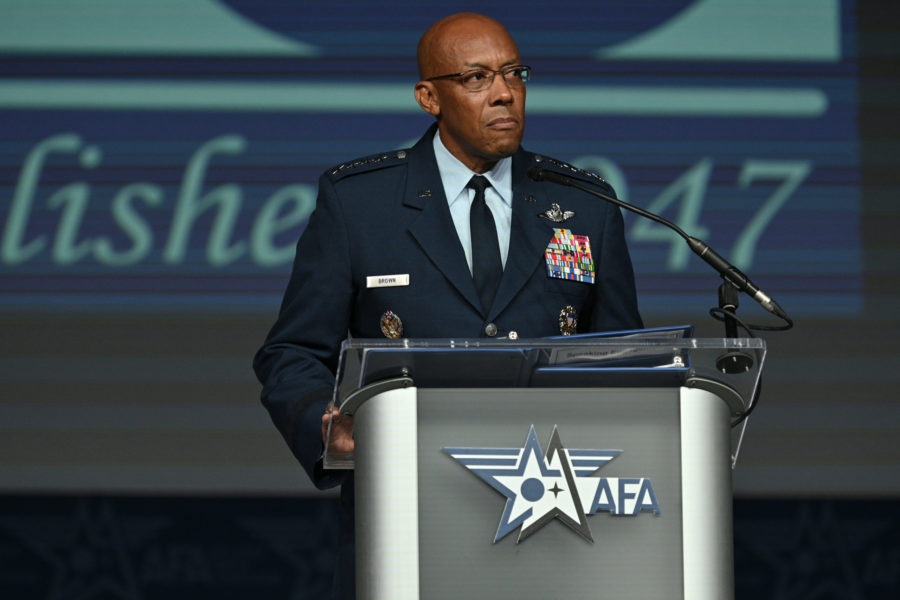As the Air Force moves forward with its efforts to operationalize the concept of agile combat employment, leaders need to embrace an iterative approach that builds on itself, recognizing that ACE may never be fully complete, Chief of Staff Gen. Charles Q. Brown Jr. said Sept. 27.
ACE as an approach is built on the idea of small teams of Airmen operating in remote or austere environments outside of traditional fixed bases, capable of performing duties outside their specialties, moving quickly when needed, and acting based on a commander’s intent rather than waiting for specific instructions.
In order for that approach to work, Brown said during Defense One’s State of the Air Force webinar, the Air Force needs a cultural shift. Specifically, leaders need to “delegate more; we need to tolerate more; and we need to iterate more,” Brown said.
Airmen’s feedback will drive that iterative approach, Brown said, as they continue to train and test the ACE concept more and more. And because it requires a mindset of flexibility and responsiveness, change will always be needed.
“I don’t know that it’ll ever be done, partly because the environment will continue to change,” Brown said. “And I don’t want us to get to a point where we slap the table and go, ‘OK, we’re done, and we’re good to go.’ We do that, and we set ourselves up for where our adversary does something we didn’t expect.”
To avoid that, Air Force leaders need to keep thinking, wargaming, and planning to ensure ACE stays fresh, Brown said.
Such an approach seemingly shares characteristics with software development and the Advanced Battle Management System, which officials have suggested will never be “a shiny platform on the end of a ramp.”
It differs, however, from other systems or concepts in which the Air Force has moved methodically toward full operational capability, typically considered the end of a development cycle.
Brown has spoken of the need for a cultural shift inside the Air Force before, most recently at AFA’s Air, Space & Cyber Conference on Sept. 19. Highlighting that need for ACE, he said Air Force leaders need to trust their Airmen to try things, especially when they’re dispersed and operating in areas where communications may be disrupted—a key assumption of ACE.
“What we don’t want is to have them sitting, waiting for instruction, while they’re being attacked or in a difficult situation,” Brown said. “I prefer that they actually be taking action to move things forward.”
With that approach, though, comes the certainty that at some point, an Airman will do something counter to how a commander wanted it done, or even mess up—what Brown termed an “‘aw, shucks’ moment.”
More exercises and training will help Airmen get some of those mistakes out of the way, so that in an operational environment, “where you don’t know what the actual outcome or actually the threat is going to be, … you’ve done enough critical thinking where you feel like you can actually make a decision,” Brown said.
But inevitably, something will go wrong in the real world. And when it does, Air Force leaders need to be prepared to work with Airmen instead of simply punishing them, Brown said.
“When things don’t go quite right, it’s how we sit down and coach our Airmen through what did go right,” Brown said. “Now there is a level of accountability. If you purposely, willfully violated some guidance, then there’s a big level of accountability. But the other thing I personally look at—if something doesn’t go right, the first thing I do is look at myself in the mirror, and then [ask] did I provide an appropriate intent, did I provide the right guidance, did I provide the right resources, did I provide them the authorities to do what we asked them to do? And sometimes I can be just as culpable as they may be because there’s some things I didn’t do to help them out.”
The need for Airmen to make decisions without fear of serious repercussions is not an issue that Brown is alone in considering. At the International Air Chiefs Conference earlier this month, leaders from the Royal Canadian Air Force and Swedish Air Force both emphasized the need as part of the broader concept of distributed operations, which ACE would include.
“If you really want to do dispersed operations, distributed control and mission command, you need to build a culture that embraces that,” Maj. Gen. Carl-Johan Edström said. “You need to train your Airmen, your enlisted … from Day 1, to make them confident, to act on the commander’s intent. And that also means that you need to embrace mistakes and learn from them instead of punishing people that are doing mistakes. And that is very difficult, and it takes time.”
Complicating that task is the need for a balance between accountability and risk-taking, Brown said. He wants to avoid being “too constrictive and now more worried about compliance versus being an effective and credible combat force.”
And when it comes to compliance, Brown also noted that the service needs to update its policies to reflect how Airmen need to operate, not the other way around.
“Sometimes I don’t know that our policies keep track or keep pace with how the operations, how the geostrategic environment changes, which means we may have some few outdated policies we’re living by,” Brown said.
